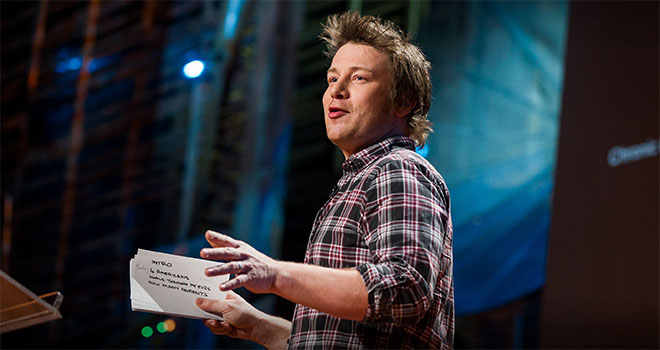How to Start a Presentation and Engage your Audience
June 27, 2018 - Dom Barnard
Why should you focus on the start of your speech? Because many studies show that if you can capture someone’s interest straight away, there’s a good chance they’ll listen to the rest of the presentation. If you don’t, the majority of listeners will focus on something else.
This article discusses different ways to start a presentation and keep your audience engaged, as well as example videos you can watch which illustrate these points.
Beginning your presentation
Depending on the event, a facilitator may introduce you to the audience or you may have to introduce yourself.
People came to the event knowing that there would be speaker or they may have even known that you specifically would be speaking. This should fill you with some confidence as the audience will want to listen to you.
Wait until the majority of the audience are paying attention before you introduce yourself and launch into your speech.
Watch examples of both a strong and weak introduction
When watching this video, compare how the speakers:
- Engage with the audience
- Use eye contact
- Use body language
- Use hesitation words
- Move on stage
Ensure that you welcome the audience and introduce yourself by stating your name, your job title and where you work. Follow this with a brief biography, including what experience you have - this will help draw attention to your ethos (credibility) because it's the best way to demonstrate your credentials to that particular audience on that particular day.
Afterwards:
- Introduce your presentation title/the question you're exploring.
- Your aims for the audience/what you hope they’ll get out of it.
- Make it clear to the audience when they should ask questions - some speakers set aside specific sections for Q&A and others prefer the audience to ask questions when they come to mind. By clarifying this during your introduction you will avoid potential disruptions.
Presentation opening ideas
It's vital to engage the audience from the start. Here are techniques for beginning a presentation:
1. Shock the audience
There are many ways to shock your audience, for example, you can show a funny video, use a prop, start by talking to audience members, ridicule something etc.
But ensure that your shock will have the desired effect - you want the audience to remain engaged because they liked the surprise or they found it interesting and not because you've upset them so they're looking for faults in your argument. Again, the shock must be suitable for your presentation's purpose and your audience.

Jamie Oliver opens his TED Talk with a starting statistic: "Sadly, in the next 18 minutes when I do our chat, four Americans that are alive will be dead through the food that they eat."
2. Ask the audience to "imagine" or think "what if"?
Asking your audience to imagine something or think ‘what if’ gets them to visualise and use their imagination. You can use this technique to evoke certain emotions which are usually the feelings you experience over the same thing.
Emotions are a great way of ensuring that people will continue listening as they are now involved in what you're saying.
3. Start your presentation in the future or the past
Symbouleutikon/deliberative rhetoric is when the speaker tries to get the audience to take action by talking about a possible future. Politicians often use this technique and a well-known example is Martin Luther's "I have a dream" speech.
You can also produce a similar reaction from the audience by talking about the past - using lessons from things that were done well, or things that didn’t work. For example, you might remind the audience of when the country was economically thriving or when mistakes were made which led to the country experiencing economic turmoil.
4. Quote someone or a proverb
If you're struggling to create a strong opening sentence consider quoting someone. However, you must be careful as you can risk sounding cliché and the quote must be meaningful and relevant to the audience and the purpose of your presentation.
If you're using slides show a photo instead of text when you're quoting. This will help the audience:
- Understand the quote
- Remember the quote
- Engage their imagination for a greater impact
5. Tell a story or joke, or reference a historical event
You could start with a story to highlight why your topic is significant. For example, if the topic is on the benefits of pets on physical and psychological health, you could present a story or a study about an individual whose quality of life significantly improved after being given a dog. The audience is more likely to respond better to and remember this story than a list of facts.
Well-known historical events are good reference points, both to illustrate a point, and to get the audience using their imagination.
More experienced and confident public speakers may start a presentation with a joke. The audience will be incredibly engaged if you make them laugh but caution must be exercised when using humour because a joke can be misinterpreted and even offend the audience. Only use jokes if you're confident with this technique and it has been successful in the past.
6. Share personal stories
As aforementioned, the audience enjoy hearing stories and they're even more interested when the story is directly about you, the speaker, because they get to see the human side of you.
Consider telling a story about a mistake you made or when life wasn't going that well - if relevant to your presentation's aim. People will relate to this as we all have experienced mistakes and failures. The more the audience relates to you, the more likely they will remain engaged.
These stories can also be told in a humorous way if it makes you feel more comfortable and because you're disclosing a personal story there is less chance of misinterpretation compared to telling a joke.
Watch this great presentation from Conor Neill on how to start a speech and engage your audience. Permission given to reuse this work - read more about Conor Neill and his services on his website: conorneill.com
7. Point to their problem or opportunity
Putting your finger on your audience’s pain point is another way of gaining their attention because you're triggering an emotional reaction again. For example, you might ask "Have you found it difficult to stick to a healthy diet?" The audience will now want to remain engaged because they want to know the solution and the opportunities that you're offering.
8. Start with a video
A pre-prepared video can provide a strong presentation opening and get people to pay attention before you start speaking. Some speakers show a video as the audience are arriving and getting settled - they may begin by reflecting on the video.
- You can use the Canva online editor to create your video
9. Ask the audience questions
You can conduct polls using your audience or ask questions to make your audience think and feel invested in your presentation. There are three different types of questions:
- Direct
- Rhetorical
- Loaded
Direct questions require an answer: "What would you do in this situation?" These are mentally stimulating for the audience. You can pass a microphone around and let the audience come to your desired solution.
Rhetorical questions do not require answers, they are often used to emphasises an idea or point: "Is the Pope catholic?
Loaded questions contain an unjustified assumption made to prompt the audience into providing a particular answer which you can then correct to support your point: You may ask "Why does your wonderful company have such a low incidence of mental health problems?" The audience will generally answer that they're happy. After receiving the answers you could then say "Actually it's because people are still unwilling and too embarrassed to seek help for mental health issues at work etc."
10. Statistics
You could begin by sharing a surprising statistic which you can personalise to the audience for a larger impact, for example, you could say "In this room, over 70% of us are going to..." or "Look to the person on your left..."
You can also combine a statistic with a leading question, for example "What percentage of the population do you think...?" The audience should be shocked when you provide them with the actual answer.
Make sure you don't go overboard with statistics or use complicated data especially in the introduction as you may lose the audience.
These techniques don't only apply for introductions - they can also be used throughout your presentation to engage and persuade your audience. Try different techniques to find out what works best for you and practice as much as possible. With a powerful opening prepared you'll feel far less nervous during the rest of your presentation.


